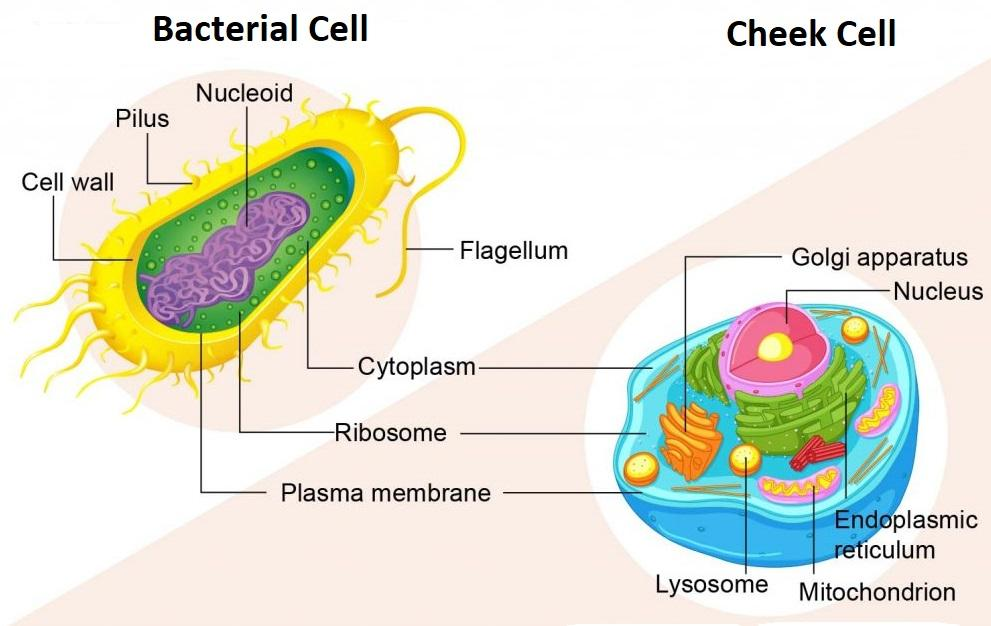
How does a bacterial cell differ from a human cheek cell?
Answer
462.9k+ views
Hint: Bacterial cells have evolved before the human cheek cells as they are traditional and simple. They are formed on the rocks, which were formed one billion years after Earth formed. They are isolated and are independent. They survive on their own. Human cheek cells are present in the cheeks of the human body. They are not isolated, present as groups and are dependent on other cells for their survival.
Complete answer:

Fig: Bacterial Cell and Human Cheek Cell
The following table displays the differences between the bacteria cell and human cheek cell:
Note:
Due to the absence of a nuclear membrane, bacteria cells differ from a human cheek cell. In addition, bacteria cells contain plasmids, while plasmids are absent in human cells. There is a single chromosome present in bacteria cells, while the human cheek cells consist of pairs of chromosomes. Hence, the bacterial cell is haploid, yet the human cheek cell is diploid. Plasmids are present in the bacterial cell and absent in the human cheek cell.
Complete answer:

Fig: Bacterial Cell and Human Cheek Cell
The following table displays the differences between the bacteria cell and human cheek cell:
| Bacteria cell | Human cheek cell |
| It is a prokaryotic cell. | It is a eukaryotic cell. |
| It lacks nuclear organization. The nuclear membrane is absent. | It possesses a nuclear organization, with the presence of a nuclear membrane, which involves the cell’s nucleus. The membrane gives rise to some intracellular structures. |
| They are capsule-shaped. | They are round cells. |
| Bacterial cells are much smaller than human cheek cells and can be present inside them. | They are much larger than bacterial cells. |
| The cell wall is present and N-acetyl glucosamine is present in the cell wall. | N-acetyl glucosamine is absent and the cell wall is absent. |
| Cellular organelles are absent. Mitochondria are absent. | There are many cellular organelles. Mitochondria are present. |
| Some bacterial cells prepare their food. | Human cheek cells do not prepare their food. |
| It is a smaller and simpler type. | It is a larger and complex type. |
| DNA molecule is not housed within a nucleus | A DNA molecule is housed within a nucleus. |
| Both mitosis and meiosis occur. | Ovum and sperm formation occurs via meiosis, Rest of the cells undergo mitosis. |
| Since it is a single cell, no cytoplasmic bridges are present. | Cytoplasmic bridges aid in inter-cellular transport between neighboring cells |
Note:
Due to the absence of a nuclear membrane, bacteria cells differ from a human cheek cell. In addition, bacteria cells contain plasmids, while plasmids are absent in human cells. There is a single chromosome present in bacteria cells, while the human cheek cells consist of pairs of chromosomes. Hence, the bacterial cell is haploid, yet the human cheek cell is diploid. Plasmids are present in the bacterial cell and absent in the human cheek cell.
Recently Updated Pages
Master Class 11 Social Science: Engaging Questions & Answers for Success

Master Class 11 Physics: Engaging Questions & Answers for Success

Master Class 11 Maths: Engaging Questions & Answers for Success

Master Class 11 Economics: Engaging Questions & Answers for Success

Master Class 11 Computer Science: Engaging Questions & Answers for Success

Master Class 11 Chemistry: Engaging Questions & Answers for Success

Trending doubts
What is meant by exothermic and endothermic reactions class 11 chemistry CBSE

10 examples of friction in our daily life

One Metric ton is equal to kg A 10000 B 1000 C 100 class 11 physics CBSE

1 Quintal is equal to a 110 kg b 10 kg c 100kg d 1000 class 11 physics CBSE

Difference Between Prokaryotic Cells and Eukaryotic Cells

The camels hump is made of which tissues a Skeletal class 11 biology CBSE




